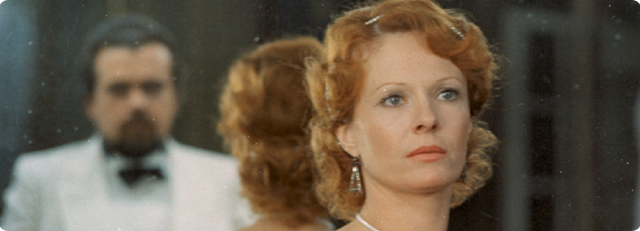Marguerite
Duras (1914–1996), the prolific author, playwright, political troublemaker, and
filmmaker, was born in Vietnam to French emigrant parents. Her family’s descent into poverty, the
madness of her mother, her early sexual adventures and abuse, and her
experience of alienation as an impoverished foreigner in prewar Indochina are
the main topics of her largely autobiographical fiction. Although she returned to France to study law
at age seventeen, Duras revisits the memories of her childhood again and
again in her work. The characters of her
novels, films, and plays reappear to be portrayed from alternative
perspectives. For Duras, an obsessive
self-analyst, her truth is not so much found in the telling as in the re-telling.
As
a filmmaker, Duras created nineteen films in all. Her sixth, “India Song” (1975), set in 1930s white colonial India (a place she visited for
only hours) but filmed in France, was originally commissioned as a play for
the National Theatre in London. The film
showcases the lush cinematography of Bruno Nuytten, a lyrical piano score by
Carlos D’Alessio, and performances by frequent Duras collaborator Delphine
Seyrig and by Michael Lonsdale in what he has noted as his favorite role. It was nominated for three César Awards in
1976 (Best Actress, Sound, and Score).
When
the film screened at Cannes, it was met with mixed reviews. The New York Times’ Vincent Canby derided it as an “overly intellectualized mistake.” Duras’
unique cinematic style demands an active spectator. To appreciate her films, one might need to do as Pauline Kael suggested in her article for The New Yorker, to bring a piece of
yourself that “you do not think to take to the movies.” Then you might experience what Molly Haskell of the Village Voice called Duras’ “most perfectly realized
film… a rarefied work of lyricism, despair, and passion.”
“India Song” presents
a dramatic situation in puzzle pieces that the audience must put together
within a frame that fits the film’s tone and tune. The film challenges the traditional relationship
of image and sound in narrative cinema. Four
faceless storytellers in a non-synced soundtrack are completely independent of
the images. The off-screen voices (including Duras’ own) recount their
memories. While the audience eavesdrops,
the screen is filled with beautiful images of white colonials as they
linger around a palatial estate in party clothes. Duras has no patience for “Downton Abbey”-type nostalgia, though. She does not celebrate the lavish lifestyle of
an early-20th-century elite. The film’s
narrative of murder, suicide, and a doomed love affair fashions a kind of lurid
funeral for colonialism.
Recently,
MIT scientists Steve Ramirez and Xu Liu have demonstrated in a laboratory what
Duras experimented with in her cinema. They proved that memories are formed,
reactivated, and manipulated. In a way, “India
Song” hints at the future narrative possibilities of immersive Virtual
Reality Environments, which will depend on the viewer’s interactions with the
sights, sounds, and sensations presented. As Kevin Brooks wrote for MIT in 2003, “to be
immersed means to be engaged, not just physically but also mentally and perhaps
also emotionally.”
Open
your memory banks and explore the unique and fascinating cinematic experience of
Marguerite Duras. In years to come, when
you are haunted by “India Song,” remember: You were never there.
Marcy
Boyle and Rachel Holzman are the filmmaking team Dpyx. Their first feature, the graphic novel-influenced
thriller “Nobody Can Cool,” is
available on DVD and VOD. Dpyx is
currently developing a number of narrative projects in addition to a
documentary about pioneering film producer, Debra Hill.
Join Marcy &
Rachel of Dpyx on Friday, February 27th at 8 PM as Seeking Our Story screens “India Song” by Marguerite Duras. At 7 PM, join @WomenNMedia for a networking session. The film screens as part of MiMoDa Studio’s Friday Night Film Club and is
sponsored by @TheDirectorList. This is a community event with donations
gratefully accepted.







